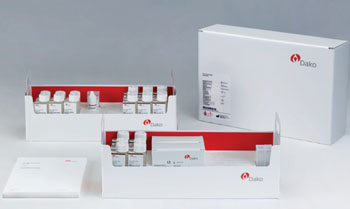FDA Approves First of its Kind Companion Dx for Lung Cancer Patients
By LabMedica International staff writers
Posted on 03 Nov 2015
The US Food and Drug Administration (FDA) have approved the first complementary diagnostic test to support use of OPDIVO (nivolumab) for non-squamous non-small-cell lung cancer (NSCLC) therapy.Posted on 03 Nov 2015
Historically, the one-year overall survival in the second-line treatment of NSCLC has been about 26%. The new test, “PD-L1 IHC 28-8 pharmDx” from Dako Denmark A/S (Glostrup, Denmark), an Agilent Technologies company, is a qualitative immunohistochemical (IHC) assay that can identify PD-L1 expression levels on the surface of NSCLC tumor cells and provide information on the survival benefit of therapy with OPDIVO for patients with non-squamous NSCLC. Dako developed the diagnostic through collaboration with Bristol-Myers Squibb, maker of OPDIVO, an immuno-oncology therapy FDA-approved for treatment of patients with previously treated NSCLC.

Image: The “PD-L1 IHC 28-8 pharmDx” immunohistochemical assay identifies PD-L1 expression levels on the surface of non-small-cell lung cancer (NSCLC) tumor cells. It is the only diagnostic assay FDA-approved to assess survival benefit associated with OPDIVO (nivolumab) therapy for patients with non-squamous NSCLC (Photo courtesy of Dako Denmark).
Dako’s test was used to assess PD-L1 expression in the Phase-3 CheckMate 057 trial, in which OPDIVO demonstrated superior overall survival in patients with previously treated metastatic non-squamous NSCLC compared to chemotherapy. The FDA on October 9, 2015, expanded the indication for OPDIVO to include previously treated non-squamous NSCLC in addition to the squamous NSCLC indication. PD-L1 IHC 28-8 pharmDx is the first and only diagnostic assay FDA-approved to assess survival benefit associated with OPDIVO. PD-L1 testing is not required for use of OPDIVO, but it may provide additional information for physicians and inform patient dialogue.
"We are excited about Agilent's involvement in these advancements and the potential PD-L1 IHC 28-8 pharmDx has in helping to provide information to oncologists considering OPDIVO for patients with non-squamous NSCLC," said Jacob Thaysen, president, Diagnostics and Genomics Group, Agilent.
"We are proud to announce the recent FDA approval of OPDIVO based upon overall survival in an expanded indication for all appropriate patients with previously treated metastatic NSCLC," added Michael Giordano, senior vice president and head of Development, Oncology, Bristol-Myers Squibb, "Our collaboration with Dako underscores our leadership in cancer innovation and our commitment to advancing research evaluating the potential role of PD-L1 in multiple tumor types."
Related Links:
Dako
PD-L1 IHC 28-8 pharmDx
Agilent Technologies














